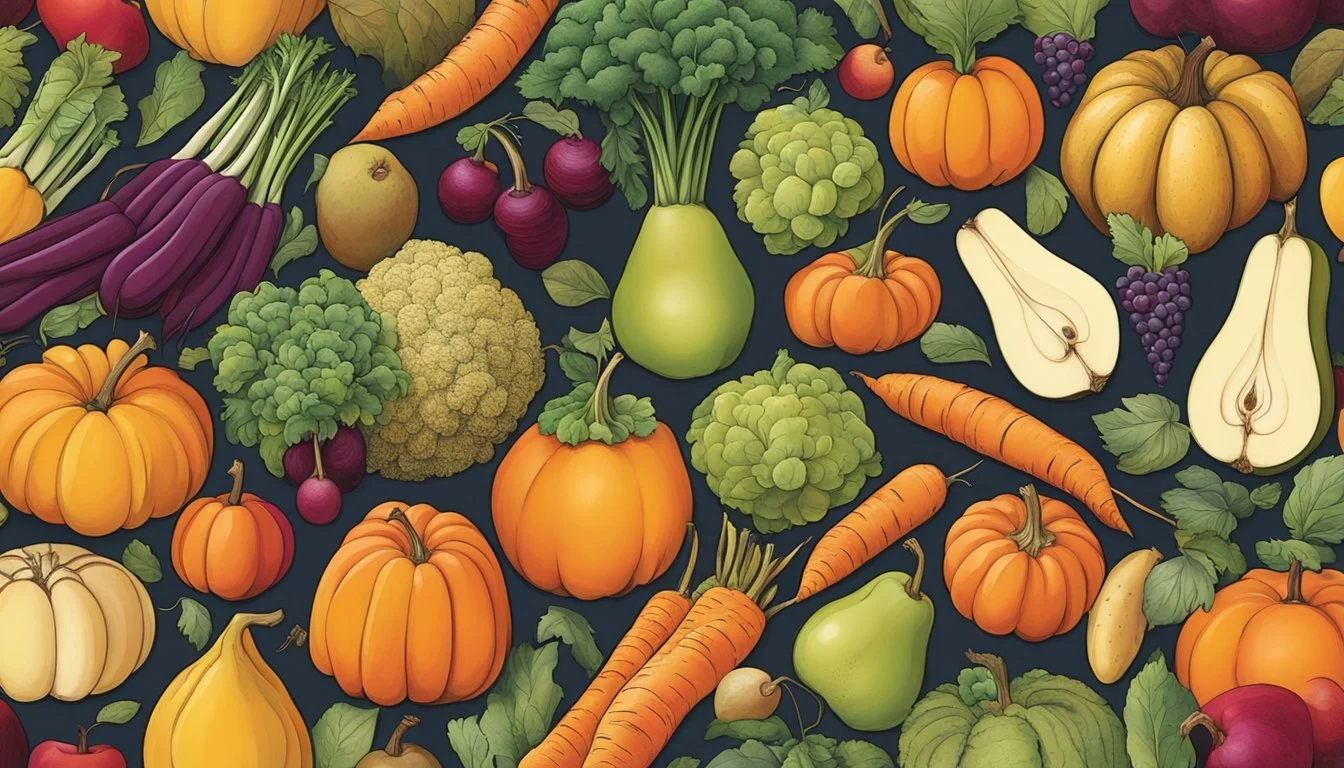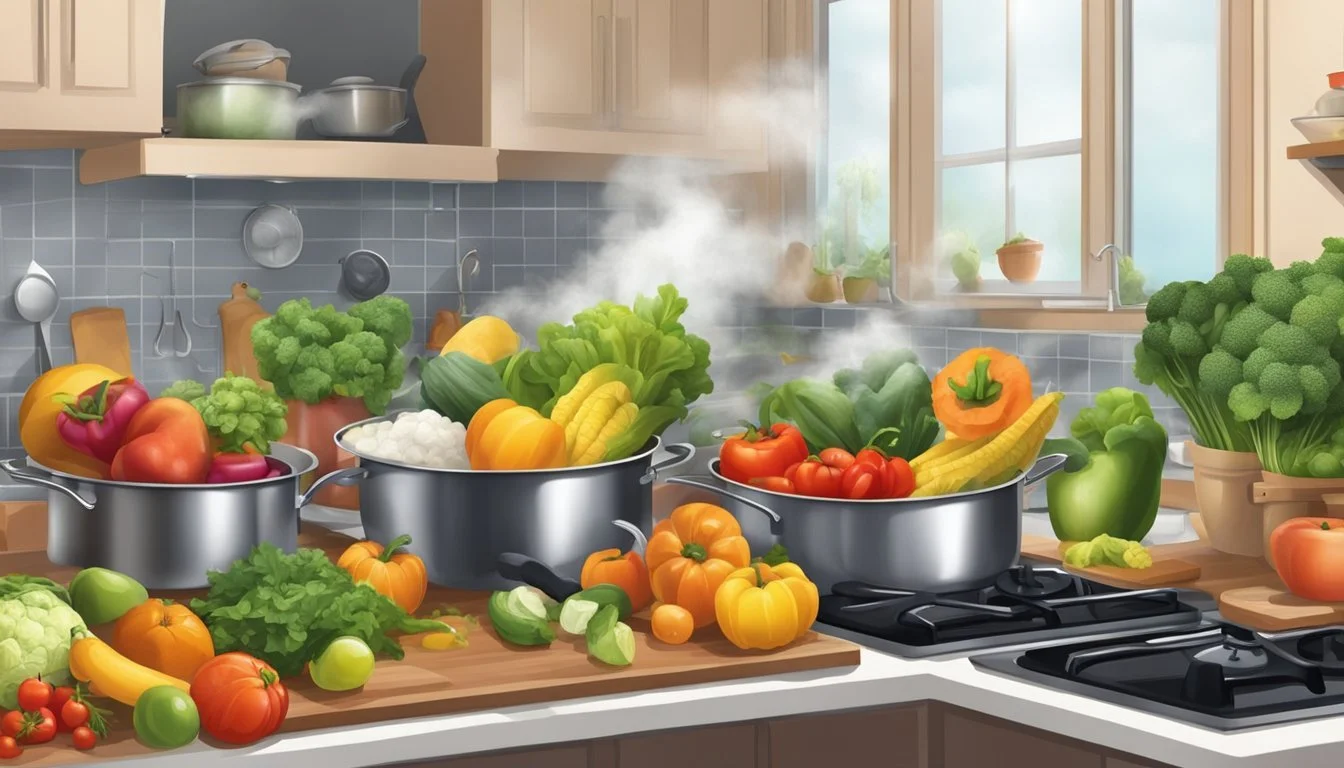New York Seasonal Fruit & Vegetables in November
A Fresh Guide to Local Produce
This Article is Part of our New York Seasonal Fruit & Veg Calendar
As November ushers in the crisp chill of late autumn in New York, a bounty of seasonal fruits and vegetables await the discerning palate. This period marks a transitional phase in the agricultural calendar where the remnants of summer harvests give way to the robust flavors of fall. Farms across the state bring to market an array of produce that not only endures but thrives in the cooler temperatures.
The harvest in New York during November is rich with a variety of root vegetables and hardy greens. Consumers can find fresh celeriac, a knobby root with a subtle celery-like flavor, ideal for soups and stews. Cauliflower, similarly robust, is also available and offers versatility in fall cooking, from roasting to pureeing. The landscapes of farmers' markets are often dotted with the vibrant greens of chard and the earthy tones of late-season root crops.
Fruits, while less abundant as the season wanes, still have a notable presence with late-harvest apples (how long do apples last?) providing a sweet-tart snap, perfect for baking or cider making. Though the variety of fruits in November is not as vast as in the summer months, the quality and depth of flavor found in available produce like cranberries, used in traditional holiday dishes, reflect the region's agricultural strength and the richness of New York's seasonal offerings.
Overview of New York's Growing Season
New York's growing season is characterized by its late harvest and diverse range of produce available. With climatic variations across regions, the state offers an array of fruits and vegetables through its distinct seasons.
Seasonal Availability Calendar
New York's harvest calendar showcases a plentiful assortment as winter approaches. In November, one generally sees the tail end of fall crops, as well as cold-weather produce that thrives in the cooling temperatures. Here is an indicative list of what to expect:
Apples: Late varieties available
Greens: Such as kale (What wine goes well with kale?) and spinach
Root Vegetables: Including carrots and beets
Winter Squash: Various types
Cabbage: Multiple varieties
Potatoes: Stored from earlier harvest
Pumpkins: End of the season
These items represent New York's November offerings which can vary year to year based on regional climates and conditions.
Eating Local Benefits
Eating local in New York has tangible benefits. It supports the state's economy and farmers, while reducing the carbon footprint associated with long-distance food transport. Seasonal produce often has enhanced flavor and freshness, adding a distinct quality to the culinary experience. Additionally, seasonal eating can contribute to a balanced diet rich in nutrients.
Seasonal Fruits in November
In November, the harvest continues in New York as the weather cools, offering fresh and locally grown fruits in markets across the state. Apples, pears, and cranberries are among the highlights of the season.
Apples
New York's apple farms remain vibrant in November, with many varieties reaching peak maturity. Consumers can expect to find fresh apples, ranging from crisp and tart to sweet and juicy. These apples are perfect for both eating raw and incorporating into seasonal recipes.
Pears
Pears are another staple in November's produce selection. They come in several varieties, each with its unique flavor and texture, ensuring a broad appeal. Pears are often available at local markets, offering a fresh alternative for those seeking variety beyond apples.
Cranberries
Cranberries, a traditional autumn fruit, are harvested in the fall and are readily available in November. They are commonly found in farmer's markets and stores, often sold fresh, but also in dried or juiced forms. Rich in flavor and nutrients, cranberries are ideal for both sweet and savory dishes.
Seasonal Vegetables in November
In November, New York's harvest brings a bounty of root vegetables and hardy greens, perfect for hearty autumn meals. The cooler weather allows for the peak flavors of these seasonal offerings.
Potatoes
Potatoes are a versatile staple. In November, they reach their peak in flavor and variety. New Yorkers can find a range of potatoes from starchy Russets to creamy Yukon Golds, suitable for a variety of dishes from roasted sides to comforting mashes.
Brussels Sprouts
Brussels sprouts thrive in the chilling temperatures of late fall. This is when they become sweet and tender, making November the perfect time to enjoy them. They can be found on stalks or pre-cut and are ideal for roasting or sautéing.
Kale
Kale is at its best in November as the cold enhances its sweetness. One can choose from curly, ornamental, or dinosaur varieties, each offering a slightly different texture and flavor profile. Kale is nutritious and can be used in everything from salads to soups.
Herbs and Other Produce
November in New York brings a variety of herbs and other produce to the table, providing rich flavors and health benefits. The cool weather is conducive to a bountiful harvest of robust herbs such as mint and oregano, which are essential for seasonal dishes.
Garlic
Garlic is a staple in many kitchens for its pungent flavor and culinary versatility. New York garlic is harvested in the summer and stored to be available well into the winter months. It can be used in its raw form for a sharp bite or roasted to bring out a sweeter, milder taste.
Parsley
Parsley, often regarded as just a garnish, is plentiful in November and offers much more than a decorative touch. Rich in vitamins and antioxidants, New York parsley thrives in the cooler temperatures, providing fresh, vibrant flavor to numerous culinary creations. Fresh parsley is best when added towards the end of cooking to preserve its delicate flavor and color.
Preparing and Cooking Seasonal Produce
In November, New York's seasonal produce like potatoes, apples, and various vegetables are at their peak, offering robust flavors. Proper storage and cooking methods can enhance their taste and longevity.
Storage Tips
Vegetables: Many of New York's November vegetables should be stored in a cool, dark place. Potatoes, for instance, are best kept in a well-ventilated container away from light to prevent sprouting. They require cooler temperatures, between 45-50°F (7-10°C), which is warmer than a refrigerator but cooler than standard room temperatures.
Leafy greens: Store unwashed in a damp paper towel, sealed in a plastic bag in the fridge.
Root vegetables (e.g., carrots, parsnips): Remove tops, store in a cool, humid environment in a mesh bag.
Fruits:
Apples: They stay crisp when refrigerated; place them in a plastic bag with holes for air circulation.
Cooking Methods
Roasting: Root vegetables and tubers benefit from roasting, which caramelizes their natural sugars and enhances their inherent sweetness. Cubed potatoes tossed in olive oil and seasoned with salt, pepper, and herbs can be roasted at 425°F (220°C) until golden.
Steaming: This gentle method preserves the color and nutrients of vegetables like kale and broccoli. One can steam them just until tender to retain their texture and vibrant color.
Sautéing: Apples can be sautéed with a dash of cinnamon for a warming side dish, or to top desserts.
Baking: Utilize baking for both savory and sweet dishes. A classic New York November dish would involve baking apples stuffed with nuts and spices or incorporating mashed potatoes into a shepherd's pie.
Farmers Markets and Local Produce
In November, New York's farmers markets transform with the seasonal shift, offering a bounty of late-autumn produce. These markets serve as critical hubs for accessing farm-fresh goods, directly connecting consumers with agricultural roots.
Finding Local Markets
New York City's vibrant farmers markets, like the acclaimed Union Square Greenmarket, bustle with activity as they provide an array of November-harvested vegetables such as Brussels sprouts, cabbage, and cauliflower. Shoppers can find local markets by:
Utilizing online resources such as GrowNYC's directory
Visiting community boards for weekly market schedules
Following social media updates from favorite markets for the latest offerings
Farmers display their produce proudly, offering the freshest picks often harvested within 24 hours of sale. They're ready to share their knowledge on storage, preparation, and flavor pairings.
Community Supported Agriculture (CSA)
Community Supported Agriculture (CSA) programs are a substantial part of the local food system, especially during the harvest-rich month of November. Participants receive shares of a farm's harvest, which might include:
Root vegetables: Carrots, beets, and celeriac
Leafy greens: Kale and swiss chard
Winter squash: Acorn, butternut, and spaghetti squash
Herbs: Such as parsley and thyme
By joining a CSA, individuals not only enjoy seasonal produce but also invest in the sustainability and success of local farms. It forges a partnership where the risks and rewards of farming are shared.






